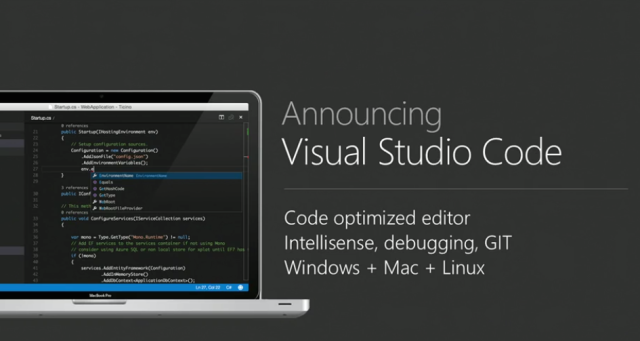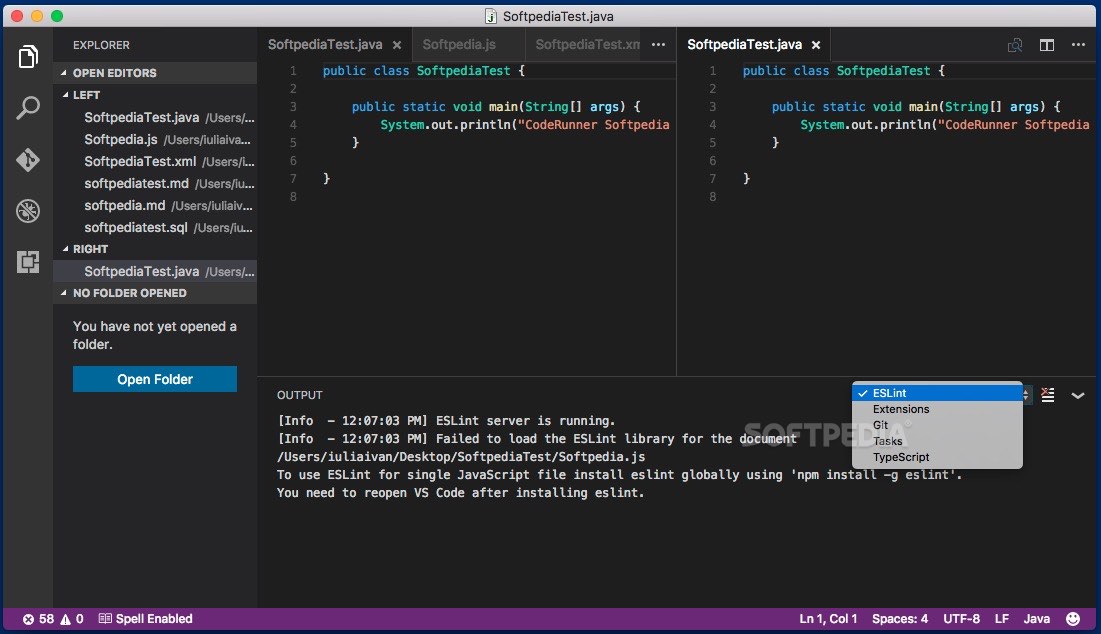January 8th, 2018
- Visual Code Editor Mac Free
- Visual Code Editor Mac Os
- Visual Studio Code Editor Mac
- Visual Studio Code Editor Macros
- Vs Code Editor.max Tokenization Line Length
Visual Code Editor Mac Free
I resisted switching to Microsoft‘sVisual Studio Code for quite awhile. Partly because I didn’t want to pay for yet another editor. I had alreadypaid for Sublime Text to upgrade to V3 and get full benefits. I ended upnot liking it anyway! Then I had WebStorm which I got because I alreadyhadPHP Storm and liked it for WordPress development. Paid for thattoo. I mainlyended upworking with the free code editorAtom, however. I loved it because of its UI and integration withGit. And the Github teamcreated it, so that made it even moreappealing. I have been deploying virtually all my Github repos togh-pages, so using Atom just made sense to me.

For JavaScript also there are numerous IDEs, and Visual Studio Code editor is one of them. It is a lightweight but strong source code editor that runs on your desktop and is available for Windows, macOS, and Linux. Visual Studio Code has built-in support for JavaScript, TypeScript, and Node.js. Visual Studio dev tools & services make app development easy for any platform & language. Try our Mac & Windows code editor, IDE, or Azure DevOps for free.

But I found that Atom was becoming VERY SLOW. The bigger my projectsgot, the slower it became. Then I also noticed that sometimes when I switchedbranches, on switching, some files did not close. They would remain open andunsaved when switching back to master. It got confusing and potentiallydangerous, because I would not know what was what. But this had never happenedbefore. Probably I had upgraded Atom, and the setting related to this issue hadgone away. That is another thing that I did not like about Atom. When oneupgraded to the latest version, certain, but not all, settings would revert todefault. I subsequently found out that there is a setting calledClose File Deleted Tabs in Core Settings that makes sure that deletedfilesactually close. That helped. But in my case what was alsohappening, was that certain changes didn’t seem to transfer over locally on agit merge even though they showed up remotely! That’s because Atom wasbecoming SO SLOW. SO I knew that at least for bigger projects, I would have tostart using something else.
Webstorm does not have the greatestUI. It also does not have thegreatest assortment of plugins. But, it is really great for remote deployment,especially to hosting services. Connecting withFTPs is a snapand things like that. So I will definitely continue to use it for specificpurposes. But I had to find something that would improve upon my dailydevelopment code editor experience. In desperation, I decided to check outMicrosoft‘s Visual Studio Code. To my amazement, I found that theeditor itself is 100% FREE! I had been under the impression that I had to payfor it. But that is not the case. So I immediately downloaded it and installedit. I am writing this blog post with it right now.
Visual Studio Code is available now for Mac. I know that in the past itwas not. There is great documentation to get you started on a Mac. You can alsosign up for Visual Studio Dev Essentials. However, if you alreadysubscribe to a Microsoft product,** i.e., *Office 365* (I do), allyou have to do is sign in with those credentials.
To download Visual Studio Code, go here. Tolearn more about running VS Code on a Mac, please visitRunning VS Code on Mac.
Have fun coding with Visual Studio Code!
- ← Newer

Getting up and running with Visual Studio Code is quick and easy. It is a small download so you can install in a matter of minutes and give VS Code a try.
Cross platform
VS Code is a free code editor, which runs on the macOS, Linux, and Windows operating systems.
Follow the platform-specific guides below:
VS Code is lightweight and should run on most available hardware and platform versions. You can review the System Requirements to check if your computer configuration is supported.
Update cadence
VS Code releases a new version each month with new features and important bug fixes. Most platforms support auto updating and you will be prompted to install the new release when it becomes available. You can also manually check for updates by running Help > Check for Updates on Linux and Windows or running Code > Check for Updates on macOS.
Note: You can disable auto-update if you prefer to update VS Code on your own schedule.
Insiders nightly build
If you'd like to try our nightly builds to see new features early or verify bug fixes, you can install our Insiders build. The Insiders build installs side-by-side with the monthly Stable build and you can freely work with either on the same machine. The Insiders build is the same one the VS Code development team uses on a daily basis and we really appreciate people trying out new features and providing feedback.
Portable mode
Visual Studio Code supports Portable mode installation. This mode enables all data created and maintained by VS Code to live near itself, so it can be moved around across environments, for example, on a USB drive. See the VS Code Portable Mode documentation for details.
Additional components
VS Code is an editor, first and foremost, and prides itself on a small footprint. Unlike traditional IDEs that tend to include everything but the kitchen sink, you can tune your installation to the development technologies you care about. Be sure to read the Additional Components topic after reading the platform guides to learn about customizing your VS Code installation.
Extensions
VS Code extensions let third parties add support for additional:
- Languages - C++, C#, Go, Java, Python
- Tools - ESLint, JSHint , PowerShell
- Debuggers - Chrome, PHP XDebug.
- Keymaps - Vim, Sublime Text, IntelliJ, Emacs, Atom, Brackets, Visual Studio, Eclipse
Extensions integrate into VS Code's UI, commands, and task running systems so you'll find it easy to work with different technologies through VS Code's shared interface. Check out the VS Code extension Marketplace to see what's available.
Next steps
Once you have installed and set up VS Code, these topics will help you learn more about VS Code:
- Additional Components - Learn how to install Git, Node.js, TypeScript, and tools like Yeoman.
- User Interface - A quick orientation to VS Code.
- Basic Editing - Learn about the powerful VS Code editor.
- Code Navigation - Move quickly through your source code.
- Debugging - Debug your source code directly in the VS Code editor.
- Proxy Server Support - Configure your proxy settings.
If you'd like to get something running quickly, try the Node.js tutorial walkthrough that will have you debugging a Node.js web application with VS Code in minutes.
Common questions
What are the system requirements for VS Code?
We have a list of System Requirements.
How big is VS Code?
VS Code is a small download (< 100 MB) and has a disk footprint of less than 200 MB, so you can quickly install VS Code and try it out.
How do I create and run a new project?
Visual Code Editor Mac Os
VS Code doesn't include a traditional File > New Project dialog or pre-installed project templates. You'll need to add additional components and scaffolders depending on your development interests. With scaffolding tools like Yeoman and the multitude of modules available through the npm package manager, you're sure to find appropriate templates and tools to create your projects.
How do I know which version I'm running?
On Linux and Windows, choose Help > About. On macOS, use Code > About Visual Studio Code.
Why is VS Code saying my installation is Unsupported?
VS Code has detected that some installation files have been modified, perhaps by an extension. Reinstalling VS Code will replace the affected files. See our FAQ topic for more details.
Visual Studio Code Editor Mac
How can I do a 'clean' uninstall of VS Code?

If you want to remove all user data after uninstalling VS Code, you can delete the user data folders Code and .vscode. This will return you to the state before you installed VS Code. This can also be used to reset all settings if you don't want to uninstall VS Code.
Visual Studio Code Editor Macros
The folder locations will vary depending on your platform:
Vs Code Editor.max Tokenization Line Length
- Windows - Delete
%APPDATA%Codeand%USERPROFILE%.vscode. - macOS - Delete
$HOME/Library/Application Support/Codeand~/.vscode. - Linux - Delete
$HOME/.config/Codeand~/.vscode.
